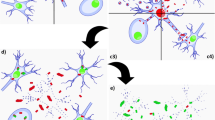New experimental data from studies of the etiopathogenesis of amyotrophic leukospongiosis (AL) obtained by immunoblotting and electron and atomic force microscopy are presented. This disease is characterized by gradual progression of flaccid paralysis of the limbs and truncal muscles with inevitable lethal outcomes due to spinal respiratory disorders; there are no impairments to cranial nerve function or pyramidal signs and all types of sensation are preserved. The main morphological appearances of AL consist of death of motoneurons throughout the spinal cord, combined with spongiosis of the white matter of the brain (axon degeneration on the background of preserved myelin sheaths). Human brain specimens obtained at autopsy from victims of AL always showed protease-resistant prion protein (PrPAL), aggregating into characteristic polymorphous amyloid-like structures. Previous studies have shown that brain homogenates and their highly purified fractions have in vitro infectivity. The new data provide evidence supporting the view that the disease has a prion nature and is one of the transmissible spongiform encephalopathies.
Similar content being viewed by others
References
V. I. Votyakov, I. I. Protas, K. G. Umanskii, et al., “A characteristic form of spinal myotrophy encountered in a limited territory in Belarus,” Zh. Nevrol. Psikhiat., No. 6, 825–829 (1975).
V. I. Votyakov, I. I. Protas, M. K. Nevzved, et al., “Experimental amyotrophic leukospongiosis,” Vopr. Virusol., No. 4, 39–44 (1983).
V. I. Votyakov, I. I. Protas, M. K. Nevzved, et al., “Amyotrophic leukospongiosis (progressive spinal amyotrophy) in clinical practice and experimental investigations,” Zh. Nevrol. Psikhiat., No. 3, 330–333 (1985).
V. I. Votyakov, N. D. Kolomiets, Z. B. Kvacheva, et al., “Studies of the physicochemical and biological properties of agents isolated from patients with amyotrophic leukospongiosis and monkeys with experimental reproduction of this disease,” Vopr. Virusol., No. 1, 58–64 (1985).
V. I. Votyakov, A. G. Kolomiets, N. D. Kolomiets, et al., “Characteristics of the etiological agents of amyotrophic leukospongiosis,” Vopr. Virusol., No. 6, 684–688 (1985).
V. I. Votyakov, N. D. Kolomiets, A. G. Kolomiets, et al., “Modeling of amyotrophic leukospongiosis in laboratory animals,” Vopr. Virusol., No. 9, 71–76 (1986).
V. I. Votyakov, I. I. Protas, N. D. Kolomiets, et al., “Clinical-morphological analysis of human amyotrophic leukospongiosis reproduced in guinea pigs,” Zh. Nevrol. Psikhiat., No. 2, 225–229 (1987).
V. I. Votyakov, N. D. Kolomiets, and I. I. Protas, “Etiology of amyotrophic leukospongiosis,” Soc. Med. Rev. Virol., No. 2, 349–377 (1987).
V. A. Zuev, I. A. Zavalishin, and V. M. Roikhel, Prion Diseases of Humans and Animals [in Russian], Meditsina, Moscow (1999).
S. P. Kapitulets, N. N. Kapitulets, N. N. Poleshchuk, et al., “Experimental evidence for the presence of an anomalous prion protein PrPd in autopsy brain specimens from humans dying from amyotrophic leukospongiosis (two new cases),” in: Current Problems in Infectious Pathology in Humans: Collected Reports [in Russian], State Research Institute of Epidemiology and Microbiology, Minsk, Belarus (2008), Iss. 1, pp. 118–122.
S. P. Kapitulets, G. K. Zhavnerko, N. N. Poleshchuk, et al., “Detection of anomalous prion protein PrP27-30 by atomic force microscopy on a locally activated surface,” ibid., pp. 111–117.
N. D. Kolomiets, V. I. Votyakov, I. I. Protas, et al., “Reproduction of amyotrophic leukospongiosis in laboratory animals,” Vopr. Virusol., No. 1, 51–59 (1986).
M. K. Nevzved, I. I. Protas, V. I. Votyakov, et al., “Morphological changes in the central nervous system in amyotrophic leukospongiosis,” Arkh. Patol., 10, 60–66 (1982).
V. I. Pokrovskii et al., Progressive Central Nervous System Infections [in Russian], Foliant, St. Petersburg (2007), pp. 112–113.
N. N. Poleshchuk, V. I. Votyakov, M. K. Nedzved, et al., “Ultrastructural changes in the CNS in amyotrophic leukospongiosis,” Arkh. Patol., No. 1, 40–45 (1985).
N. N. Poleshchuk, S. P. Kapitulets, Yu. G. Ilkevich, and Z. B. Kvacheva, “Use of electron microscopy for the diagnosis of spongiose encephalopathies,” Lab Delo, No. 4, 42–44 (1991).
N. N. Poleshchuk, S. P. Kapitulets, N. N. Kapitulets, et al., “The infectivity of proteins of 18–20 kDal isolated from the brains of patients dying from amyotrophic leukospongiosis,” Byull. Eksperim. Biol. Med., No. 10, 409–412 (1993).
I. I. Protas, I. P. Antonov, V. I. Votyakov, and M. K. Nedzved, “Clinical features and diagnosis of amyotrophic leukospongiosis,” Zh. Nevrol. Psikhiat., No. 3, 61–66 (1982).
B. Caughey and B. Chesebro, “Prion protein and the transmissible spongiform encephalopathies,” Cell Biol., 7, 56–62 (1997).
L. Cervenakova et al., “Progressive muscular atrophy variant of familial amyotrophic lateral sclerosis (PMA/ALS),” J. Neurol. Sci., 177, 124–130 (2000).
T. Hart and P. Shears, Color Atlas of Medical Microbiology, London (1996).
P. A. Merz, R. G. Rohwer, B. Kascsak, et al., “Infection-specific particle from the unconventional slow virus diseases,” Science, 225, 437–440 (1984).
S. B. Prusiner, “Shattuck lecture – neurodegenerative diseases and prions,” New Eng. J. Med., 344, 1516–1526 (2001).
J. D. F. Wadsworth and J. Collinge, “Update on human prion disease,” Biochem. Biophys. Acta 1772, 598–609 (2007).
Author information
Authors and Affiliations
Corresponding author
Additional information
Translated from Zhurnal Nevrologii i Psikhiatrii imeni S. S. Korsakova, Vol. 110, No. 8, pp. 65–71, August, 2010.
Rights and permissions
About this article
Cite this article
Kapitulets, S.P., Protas, I.I., Nedzved, M.K. et al. New Evidence for the Prion Nature of Amyotrophic Leukospongiosis. Neurosci Behav Physi 41, 857–864 (2011). https://doi.org/10.1007/s11055-011-9499-1
Published:
Issue Date:
DOI: https://doi.org/10.1007/s11055-011-9499-1




